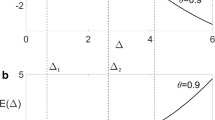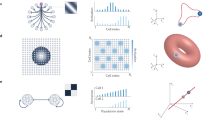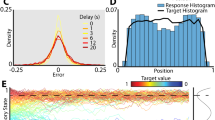Abstract
Continuous bump attractor networks (CANs) have been widely used in the past to explain the phenomenology of working memory (WM) tasks in which continuous-valued information has to be maintained to guide future behavior. Standard CAN models suffer from two major limitations: the stereotyped shape of the bump attractor does not reflect differences in the representational quality of WM items and the recurrent connections within the network require a biologically unrealistic level of fine tuning. We address both challenges in a two-dimensional (2D) network model formalized by two coupled neural field equations of Amari type. It combines the lateral-inhibition-type connectivity of classical CANs with a locally balanced excitatory and inhibitory feedback loop. We first use a radially symmetric connectivity to analyze the existence, stability and bifurcation structure of 2D bumps representing the conjunctive WM of two input dimensions. To address the quality of WM content, we show in model simulations that the bump amplitude reflects the temporal integration of bottom-up and top-down evidence for a specific combination of input features. This includes the network capacity to transform a stable subthreshold memory trace of a weak input into a high fidelity memory representation by an unspecific cue given retrospectively during WM maintenance. To address the fine-tuning problem, we test numerically different perturbations of the assumed radial symmetry of the connectivity function including random spatial fluctuations in the connection strength. Different to the behavior of standard CAN models, the bump does not drift in representational space but remains stationary at the input position.













Similar content being viewed by others
Data Availability
Data sharing not applicable to this article as no datasets were generated or analysed during the current study.
References
Amari S (1977) Dynamics of pattern formation in lateral-inhibition type neural fields. Biol Cybern 27(2):77–87
Avitabile D (2016) Numerical computation of coherent structures in spatially-extended systems. Second International Conference on Mathematical Neuroscience, Antibes Juan-les-Pins, 2016
Barak O, Tsodyks M (2014) Working models of working memory. Curr Opin Neurobiol 25:20–24
Barbosa J, Stein H, Martinez RL et al. (2020) Interplay between persistent activity and activity-silent dynamics in the prefrontal cortex underlies serial biases in working memory. Nat Neurosci 23(8):1016–1024
Bergström F, Eriksson J (2018) Neural evidence for non-conscious working memory. Cereb Cortex 28(9):3217–3228
Bressloff PC (2012) Spatiotemporal dynamics of continuum neural fields. J Phys A Math Theor 45(3):033001
Bressloff PC, Coombes S (2013) Neural bubble dynamics revisited. Cognit Comput 5(3):281–294
Bressloff PC, Wilkerson J (2012) Traveling pulses in a stochastic neural field model of direction selectivity. Front Comput Neurosci 6:90
Brody CD, Romo R, Kepecs A (2003) Basic mechanisms for graded persistent activity: discrete attractors, continuous attractors, and dynamic representations. Curr Opin Neurobiol 13(2):204–211
Camperi M, Wang XJ (1998) A model of visuospatial working memory in prefrontal cortex: recurrent network and cellular bistability. J Comput Neurosci 5(4):383–405
Constantinidis C, Wang XJ (2004) A neural circuit basis for spatial working memory. Neuroscientist 10(6):553–565
Constantinidis C, Franowicz MN, Goldman-Rakic PS (2001) The sensory nature of mnemonic representation in the primate prefrontal cortex. Nat Neurosci 4(3):311–316
Drucker DM, Kerr WT, Aguirre GK (2009) Distinguishing conjoint and independent neural tuning for stimulus features with FMRI adaptation. J Neurophysiol 101(6):3310–3324
Erlhagen W, Bicho E (2006) The dynamic neural field approach to cognitive robotics. J Neural Eng 3(3):R36
Ferreira F, Wojtak W, Sousa E et al. (2020) Rapid learning of complex sequences with time constraints: a dynamic neural field model. IEEE Trans Cogn Develop Syst 13(4):853–864
Gazzaley A, Nobre AC (2012) Top-down modulation: bridging selective attention and working memory. Trends Cogn Sci 16(2):129–135
Itskov V, Hansel D, Tsodyks M (2011) Short-term facilitation may stabilize parametric working memory trace. Front Comput Neurosci 5:40
Johnson JS, Spencer JP, Schöner G (2008) Moving to higher ground: the dynamic field theory and the dynamics of visual cognition. New Ideas Psychol 26(2):227–251
Johnson JS, Spencer JP, Luck SJ et al. (2009) A dynamic neural field model of visual working memory and change detection. Psychol Sci 20(5):568–577
Khona M, Fiete IR (2021) Attractor and integrator networks in the brain. arXiv preprint arXiv:2112.03978
Kilpatrick ZP, Ermentrout B (2013) Wandering bumps in stochastic neural fields. SIAM J Appl Dyn Syst 12(1):61–94
Klyszejko Z, Rahmati M, Curtis CE (2014) Attentional priority determines working memory precision. Vision Res 105:70–76
Koulakov AA, Raghavachari S, Kepecs A et al. (2002) Model for a robust neural integrator. Nat Neurosci 5(8):775–782
Lewis-Peacock JA, Drysdale AT, Oberauer K et al. (2012) Neural evidence for a distinction between short-term memory and the focus of attention. J Cogn Neurosci 24(1):61–79
Lim S, Goldman MS (2013) Balanced cortical microcircuitry for maintaining information in working memory. Nat Neurosci 16(9):1306–1314
Ma WJ, Husain M, Bays PM (2014) Changing concepts of working memory. Nat Neurosci 17(3):347–356
Mégardon G, Tandonnet C, Sumner P et al. (2015) Limitations of short range Mexican hat connection for driving target selection in a 2d neural field: activity suppression and deviation from input stimuli. Front Comput Neurosci 9:128
Mongillo G, Barak O, Tsodyks M (2008) Synaptic theory of working memory. Science 319(5869):1543–1546
Pina JE, Bodner M, Ermentrout B (2018) Oscillations in working memory and neural binding: a mechanism for multiple memories and their interactions. PLoS Comput Biol 14(11):e1006517
Rankin J, Avitabile D, Baladron J et al. (2014) Continuation of localized coherent structures in nonlocal neural field equations. SIAM J Sci Comput 36(1):B70–B93
Renart A, Song P, Wang XJ (2003) Robust spatial working memory through homeostatic synaptic scaling in heterogeneous cortical networks. Neuron 38(3):473–485
Rose NS, LaRocque JJ, Riggall AC et al. (2016) Reactivation of latent working memories with transcranial magnetic stimulation. Science 354(6316):1136–1139
Roux F, Uhlhaas PJ (2014) Working memory and neural oscillations: alpha-gamma versus theta-gamma codes for distinct WM information? Trends Cogn Sci 18(1):16–25
Rubin JE, Troy WC (2004) Sustained spatial patterns of activity in neuronal populations without recurrent excitation. SIAM J Appl Math 64(5):1609–1635
Schneegans S, Bays PM (2017) Restoration of fMRI decodability does not imply latent working memory states. J Cogn Neurosci 29(12):1977–1994
Schöner G, Spencer JP (2016) Dynamic thinking: a primer on dynamic field theory. Oxford University Press
Scotti PS, Hong Y, Leber AB et al. (2021) Visual working memory items drift apart due to active, not passive, maintenance. J Exp Psychol Gen 150(12):2506
Sergent C, Wyart V, Babo-Rebelo M et al. (2013) Cueing attention after the stimulus is gone can retrospectively trigger conscious perception. Curr Biol 23(2):150–155
Stokes MG (2015) Activity-silent working memory in prefrontal cortex: a dynamic coding framework. Trends Cogn Sci 19(7):394–405
Sutterer DW, Foster JJ, Adam KC et al. (2019) Item-specific delay activity demonstrates concurrent storage of multiple active neural representations in working memory. PLoS Biol 17(4):e3000239
Tanaka Y, Sagi D (1998) A perceptual memory for low-contrast visual signals. Proc Natl Acad Sci 95(21):12729–12733
Ursino M, Cesaretti N, Pirazzini G (2023) A model of working memory for encoding multiple items and ordered sequences exploiting the theta-gamma code. Cogn Neurodyn 17:489–521
Wildegger T, Humphreys G, Nobre AC (2016) Retrospective attention interacts with stimulus strength to shape working memory performance. PloS One 11(10):e0164174
Wimmer K, Nykamp DQ, Constantinidis C et al. (2014) Bump attractor dynamics in prefrontal cortex explains behavioral precision in spatial working memory. Nat Neurosci 17(3):431–439
Wojtak W, Ferreira F, Bicho E, et al. (2019) Neural field model for measuring and reproducing time intervals. In: International conference on artificial neural networks, Springer, pp 327–338
Wojtak W, Coombes S, Avitabile D et al. (2021) A dynamic neural field model of continuous input integration. Biol Cybern 115(5):451–471
Wojtak W, Ferreira F, Vicente P et al. (2021) A neural integrator model for planning and value-based decision making of a robotics assistant. Neural Comput Appl 33(8):3737–3756
Wu S, Hamaguchi K, Si Amari (2008) Dynamics and computation of continuous attractors. Neural Comput 20(4):994–1025
Xie X, Giese MA (2002) Nonlinear dynamics of direction-selective recurrent neural media. Phys Rev E 65(5):051904
Zhang K (1996) Representation of spatial orientation by the intrinsic dynamics of the head-direction cell ensemble: a theory. J Neurosci 16(6):2112–2126
Zou X, Ji Z, Liu X, et al. (2017) Learning a continuous attractor neural network from real images. In: International conference on neural information processing, Springer, pp 622–631
Zylberberg J, Strowbridge BW (2017) Mechanisms of persistent activity in cortical circuits: possible neural substrates for working memory. Annu Rev Neurosci 40:603
Acknowledgments
The work received financial support from FCT through the PhD fellowship PD/BD/128183/2016, the project “Neurofield” (PTDC/MAT-APL/31393/2017), the Project I-CATER: Intelligent robotic Coworker Assistant for industrial Tasks with an Ergonomics Rationale (Refª PTDC/EEI-ROB/3488/20211), R&D Units Project Scope: UIDB/00319/2020” - ALGORITMI Research Centre and the Research Centre CMAT within the project UID/MAT/00013/2020.
Author information
Authors and Affiliations
Corresponding authors
Ethics declarations
Conflict of interest
The authors declare that they have no conflict of interest.
Additional information
Publisher's Note
Springer Nature remains neutral with regard to jurisdictional claims in published maps and institutional affiliations.
Appendices
Appendix A
The double integral in (5) can be calculated using the Fourier transforms and Bessel function identities (Bressloff 2012). We start with expressing w(r) as a 2D Fourier transform using polar coordinates
where \(\widehat{w}\) denotes the Fourier transform of w and \({\textbf {k}} = (\rho ,\phi )\). Using the integral representation
where \(J_{0}\) is the Bessel function of the first kind, we express w in terms of its Hankel transform of order zero
which, when substituted into (5), gives
We reverse the order of integration and use the addition theorem
where \(\epsilon _{0} = 1\) and \(\epsilon _{n} = 2\) for \(n \ge 1\). Then using the identity \(J_{1}(\rho R)R = \rho \int _{0}^{R}J_{0}(\rho r')r' \textrm{d}r'\), we obtain (6). Note that the Fourier transform of (4) is easily calculated using the result that the Fourier transform of \(K_0 \left( \dfrac{r}{\sigma } \right) = \dfrac{ 2\pi }{r^2 + \sigma ^2}\).
Appendix B
Using polar coordinates we can rewrite system (8) as
We look for solutions of the form
where n is the number of modes of the boundary perturbation. System (19) then takes the form
We set \(r=R\) and after dividing both sides by \(\textrm{e}^{in\phi }\) we get
The system (22) can be written as
where the matrix A is given by
with
Then, we find that
Hence the eigenvalues of A are
Note that \(\lambda _{n}\) is real, since after setting \(\sqrt{2-2\cos \phi } = 2\sin \left( \frac{\phi }{2}\right)\) and rescaling \(\phi\) we have
i.e., the integrand is odd-symmetric about \(\frac{\pi }{2}\). Hence,
with the integrand even-symmetric about \(\frac{\pi }{2}\).
We then evaluate the integral in (28) using Bessel functions
We differentiate (6a) with respect to r, and, knowing that \(U(r)+V(r)=K\) we have
We can now write the eigenvalues of A as (9) and (10).
Appendix C
Numerical simulations of the model were done in MATLAB using a forward Euler method with uniform spatial mesh with \(\textrm{dx}=0.05\) and time step \(\textrm{dt}=0.01\). To compute the two-dimensional spatial convolution of w and f we employ a two-dimensional fast Fourier transform (2D FFT), using MATLAB’s in-built functions fft2 and ifft2 to perform the Fourier transform and the inverse Fourier transform, respectively. Periodic boundary conditions are used. By choosing a sufficiently large domain size, we make sure that the localized patterns evolve sufficiently far from the boundaries.
For performing numerical continuation, we use the method described in (Rankin et al. 2014) and adapt MATLAB code available in (Avitabile 2016). The main advantage of this method is that it can be applied directly to the full integral model. This is possible due to the usage of Newton-GMRES solvers combined with a fast Fourier transform (FFT) employed for computing the convolution term (Rankin et al. 2014).
Rights and permissions
Springer Nature or its licensor (e.g. a society or other partner) holds exclusive rights to this article under a publishing agreement with the author(s) or other rightsholder(s); author self-archiving of the accepted manuscript version of this article is solely governed by the terms of such publishing agreement and applicable law.
About this article
Cite this article
Wojtak, W., Coombes, S., Avitabile, D. et al. Robust working memory in a two-dimensional continuous attractor network. Cogn Neurodyn (2023). https://doi.org/10.1007/s11571-023-09979-3
Received:
Revised:
Accepted:
Published:
DOI: https://doi.org/10.1007/s11571-023-09979-3




